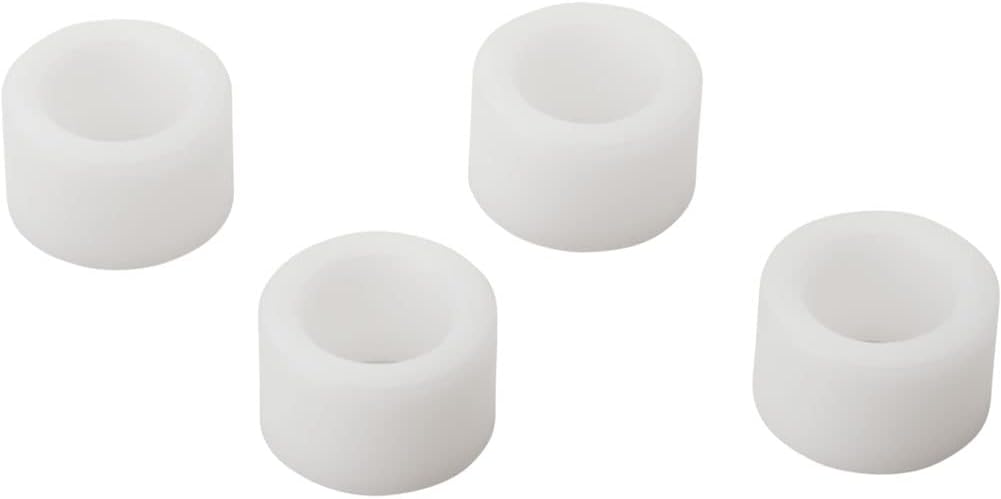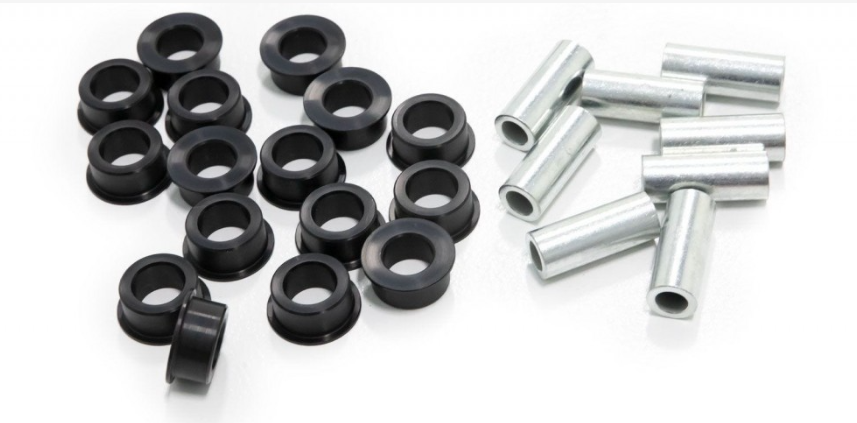
How do UHMW bushings contribute to the overall efficiency of equipment?
UHMW (Ultra-High Molecular Weight Polyethylene) bushings contribute to the overall efficiency of equipment in several ways. Here’s a detailed explanation:
1. Friction Reduction:
UHMW bushings have excellent self-lubricating properties and a low coefficient of friction. By reducing friction between moving parts, UHMW bushings minimize energy losses due to mechanical resistance. This results in smoother and more efficient operation of equipment, allowing for improved power transmission and reduced wear on components.
2. Wear Resistance:
UHMW bushings exhibit exceptional wear resistance, even under challenging operating conditions. They can withstand high loads and abrasive environments without significant wear or degradation. By minimizing wear, UHMW bushings help to maintain the dimensional integrity of equipment components and extend their service life. This reduces the frequency of maintenance and replacement, contributing to overall equipment efficiency.
3. Noise Reduction:
UHMW bushings have inherent noise-dampening properties. Their self-lubricating nature helps to reduce friction-induced vibrations and noise generated during equipment operation. By minimizing noise levels, UHMW bushings contribute to a quieter working environment, particularly in applications where noise reduction is critical, such as precision machinery or equipment used in noise-sensitive areas.
4. Corrosion Resistance:
UHMW bushings are highly resistant to corrosion and chemical attack. They are unaffected by most acids, alkalis, and solvents, making them suitable for use in harsh environments. By maintaining their structural integrity and performance in the presence of corrosive substances, UHMW bushings help prevent equipment damage and ensure consistent operation, thus enhancing overall equipment efficiency.
5. Low Maintenance:
Due to their exceptional durability and self-lubricating properties, UHMW bushings require minimal maintenance. They do not need frequent lubrication or adjustments, reducing the time and resources spent on equipment upkeep. The low maintenance requirements of UHMW bushings contribute to improved equipment uptime, increased productivity, and lower maintenance costs.
6. Weight Reduction:
UHMW bushings are lightweight compared to many other materials used for bushings. This can contribute to weight reduction in equipment, especially in applications where weight is a critical factor, such as aerospace, automotive, or portable equipment. By reducing the overall weight of equipment, UHMW bushings can improve energy efficiency and facilitate easier handling and transportation.
In summary, UHMW bushings contribute to the overall efficiency of equipment by reducing friction, providing exceptional wear resistance, minimizing noise levels, offering corrosion resistance, requiring low maintenance, and enabling weight reduction. Their positive impact on equipment operation, longevity, and performance can result in improved productivity, reduced downtime, and cost savings.

What are the maintenance and installation guidelines for UHMW bushings?
Maintenance and installation guidelines for UHMW (Ultra-High Molecular Weight Polyethylene) bushings are important to ensure their proper functioning and longevity. Here’s a detailed explanation:
1. Proper Handling:
Handle UHMW bushings with clean hands or gloves to prevent contamination. Avoid dropping or mishandling the bushings, as this can cause damage or deformations that may affect their performance.
2. Cleaning:
Regularly clean the UHMW bushings to remove dirt, debris, or contaminants that may accumulate over time. Use a mild detergent or a solution of water and soap to clean the bushings. Avoid using harsh chemicals or solvents that can degrade or damage the UHMW material.
3. Lubrication:
UHMW bushings have inherent self-lubricating properties, but in certain applications or operating conditions, additional lubrication may be necessary. Consult with the manufacturer or supplier for lubrication recommendations specific to your application. If lubrication is required, use lubricants compatible with UHMW and follow the recommended application methods and intervals.
4. Installation:
Follow proper installation procedures to ensure the correct fit and alignment of UHMW bushings. Consider the following guidelines:
- Ensure that the shaft or pivot surface is clean and free from burrs or sharp edges that could damage the bushing.
- Inspect the bushings for any visible defects or damage before installation. Do not install damaged bushings.
- Apply a controlled force or use appropriate tools to press or slide the UHMW bushings into position. Avoid excessive force that could cause deformation or stress concentration.
- Verify that the bushing is securely seated and properly aligned with the shaft or pivot. Check for smooth rotation or movement without binding or excessive play.
5. Monitoring:
Regularly inspect the UHMW bushings during operation to identify any signs of wear, damage, or degradation. This may include visual inspection, monitoring for unusual noise or vibration, or checking for changes in performance. If any issues are detected, address them promptly by replacing or repairing the bushings as necessary.
6. Environmental Considerations:
Take into account the environmental conditions in which the UHMW bushings operate. Extreme temperatures, exposure to chemicals, UV radiation, or other factors can impact the performance and durability of the bushings. If the operating conditions deviate significantly from the recommended range, consult with the manufacturer or supplier for guidance on appropriate measures to mitigate potential issues.
7. Manufacturer’s Guidelines:
Always refer to the manufacturer’s guidelines, recommendations, and technical documentation for specific maintenance and installation instructions related to the UHMW bushings. They can provide valuable information and insights tailored to the particular product and application.
In summary, proper maintenance and installation guidelines for UHMW bushings involve handling with care, regular cleaning, appropriate lubrication if necessary, following proper installation procedures, monitoring for wear or damage, considering environmental factors, and referring to the manufacturer’s guidelines. By adhering to these guidelines, you can ensure the optimal performance, longevity, and reliability of UHMW bushings in your application.

What is UHMW, and how is it used in the manufacturing of bushings?
UHMW (Ultra-High Molecular Weight Polyethylene) is a type of thermoplastic polymer known for its exceptional strength, durability, and low friction properties. It is commonly used in the manufacturing of bushings due to its unique characteristics. Here’s a detailed explanation:
Properties of UHMW:
UHMW possesses several key properties that make it suitable for bushing manufacturing:
- High Molecular Weight: UHMW has an extremely high molecular weight, which contributes to its excellent strength and toughness. It allows UHMW to withstand high loads and impact forces without deformation or failure.
- Low Friction: UHMW has a very low coefficient of friction, which means it exhibits minimal resistance to sliding or rubbing against other surfaces. This low friction property reduces wear and frictional heat generation, making it an ideal material for bushings.
- Self-Lubricating: UHMW has inherent self-lubricating properties, meaning it requires minimal external lubrication to reduce friction. Its molecular structure allows for the formation of a lubricating film on the surface, reducing the need for additional lubrication.
- Chemical Resistance: UHMW is highly resistant to many chemicals, acids, solvents, and other corrosive substances. This chemical resistance helps protect the bushings from degradation and ensures their long-term performance in various environments.
- Abrasion Resistance: UHMW exhibits excellent abrasion resistance, enabling it to withstand wear caused by repetitive sliding or rubbing motions. This property is critical for bushings that experience frequent motion and contact with other components.
- Low Water Absorption: UHMW has low water absorption properties, which means it does not absorb moisture easily. This characteristic helps prevent swelling, distortion, or dimensional changes in the bushings when exposed to moisture or humidity.
Manufacturing of Bushings:
UHMW is used in the manufacturing of bushings through various processes such as injection molding, compression molding, or machining. The specific manufacturing method depends on the desired shape, size, and application requirements of the bushings.
During the manufacturing process, UHMW can be formed into bushings with precise dimensions and tolerances. The material’s high strength allows it to withstand the loads and forces experienced by bushings, while its low friction properties contribute to smooth operation and reduced wear.
UHMW bushings find applications in a wide range of industries, including automotive, machinery, food processing, material handling, and more. They are commonly used in applications where low friction, high wear resistance, chemical resistance, and dimensional stability are essential.
Overall, UHMW is a versatile material that offers exceptional properties for bushing manufacturing, making it a popular choice for various industries and applications.


editor by CX 2024-05-16